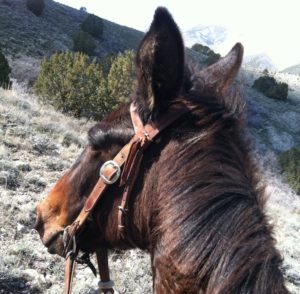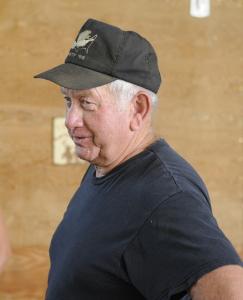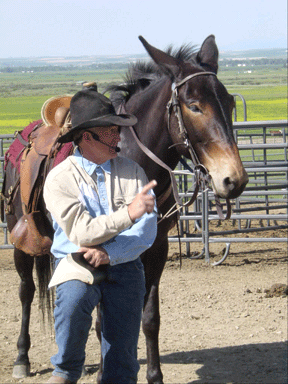The other day, I was chatting with friend, Elijah Moore, about my progress with Jolene, the new mule. He’s spent more time with horses than mules, but still had some amusing, insightful words:
“Mules are unique because they think. Mules are to horses as goats are to sheep,” he laughed.
Perfect!
That’s been my observation, too. The mule, like the goat, will stare at you or require further convincing and explanation. Once it understands, you may proceed.
Since the last post about progress with Jolene, we’ve ridden out solo a dozen times and have joined others on long rides, too. Saddling continues to be a sticking point. As Elijah taught me years ago, I employ the kinda-sorta tying method for her: I use a rope halter with a 20-foot line and never tie her hard and fast (even with a quick release knot). Instead, I loop it several times around the cylindrical fence rail. That way, when I show her the still-scary saddle pad, she can feel the tension on the line, move back ten feet to give it another look, and still be contained. She’s not ready for ground tying or being tied hard, in my humble.
 On the trail, she’s steady as a rock. Except when she isn’t. Oddly enough, she tends not to balk or bolt at things my horses would initially consider scary – like dirt bikes or an odd plastic bag blowing by. But she has startled at random moments, as I’m learning mules tend to do more than horses:
On the trail, she’s steady as a rock. Except when she isn’t. Oddly enough, she tends not to balk or bolt at things my horses would initially consider scary – like dirt bikes or an odd plastic bag blowing by. But she has startled at random moments, as I’m learning mules tend to do more than horses:
- When I checked the cinch
- When, after a one-rein stop, I released the rein quickly
- While crossing a stream, with steep embankments on both sides, she suddenly decided she wanted nothing to do with the process and bolted back up a near-vertical face, through thick brush and ledge. After returning (with a few scrapes and scratches on both of us) to the stream, she crossed it without incident.
I’m reminded of Steve Edwards, a mule man I met at the Equine Affaire years ago. Arguing against the overused, super-misunderstood concept of Desensitization, he writes:
We’re supposed to introduce everything we can think of – tarps, umbrellas, big balls, jackets, air horns, gunshot sounds, sirens, barking dogs,– my goodness, the list is endless. By desensitizing, many claim our equines will learn to tolerate things that can scare them. But spooking is a natural reaction to something that they fear might harm them.
My counter offer is to establish a relationship with your mule that says to him, “Buddy, as long as you are with me and following my leadership, you are safe. I am the level head and the way to survival.” If the mule gets even a whiff of doubt, he may try to make his own decisions about survival and trust me when I say, you may not like the result.
Remember, the actual “thing” is not what’s scary, it is your equine’s possible reaction that you worry about. Take that out of the equation.
If everything goes as it should, it creates the illusion that your mule is taking care of you, but in reality, he is simply following competent leadership. He is not “bombproof” or “desensitized” – he is well-trained and has a leader he can depend on.
Great points, Steve! Especially from my vantage point, atop a wonderful mule in the rugged Oquirrhs, where different, crazy stuff happens every day.


